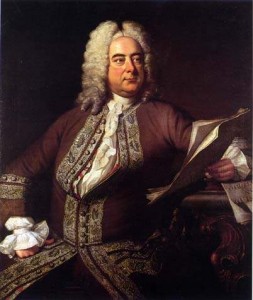Handel, Suite No. 5 in E Major (HWV 430)
 George Frideric Handel (1685-1759) wrote a total of 22 keyboard suites. Eight of those are grouped together and referred to as the eight great suites (HWV 426-433).
George Frideric Handel (1685-1759) wrote a total of 22 keyboard suites. Eight of those are grouped together and referred to as the eight great suites (HWV 426-433).
We looked at some late Renaissance precursors to the suite in the past few weeks and an early Baroque example last week by Praetorius. The typical suite as of about 1650 included the dances allemande, courante, sarabande, and gigue in that order, but you can find numerous variations, additions, and omissions.
Scholars trace the allemande to 16th-century France. It bears some similarity to the pavan with its duple meter and walking tempo. In contrast, courante literally means running. The sarabande comes from Spain. The gigue derives from the British jig. It became a standard part of the suite slightly after the establishment of the allemande-courante-sarabande formulation. David Fuller writing in Groves notes that the gigue was never as firmly attached as the others.
The suite developed somewhat differently from one country to another, although it seems clear that composers knew and were influenced by what was happening in other regions. The French often added gavottes and minuets. English composers frequently omitted the gigue. A prelude often preceded the allemande. Publishers rearranged the order of movements, and performances might mix dance movements from various suites.
Handel published his Suite in E Major in 1720. It consists of a prelude, allemande (at 1:55 in the video), courante (at 5:25), and air with variations (at 6:55). The air has acquired the name “harmonious blacksmith,” although that title first appeared well after Handel’s death.
Handel of course wrote for the harpsichord and not the modern piano. They are very different instruments. People disagree about the proper style for playing Baroque works on modern instruments, or whether one should even attempt such a thing. We can explore that issue another day. This pianist does many things with articulation and voicing that can only be done on piano. So it’s a modern performance, but I think a very good one.



